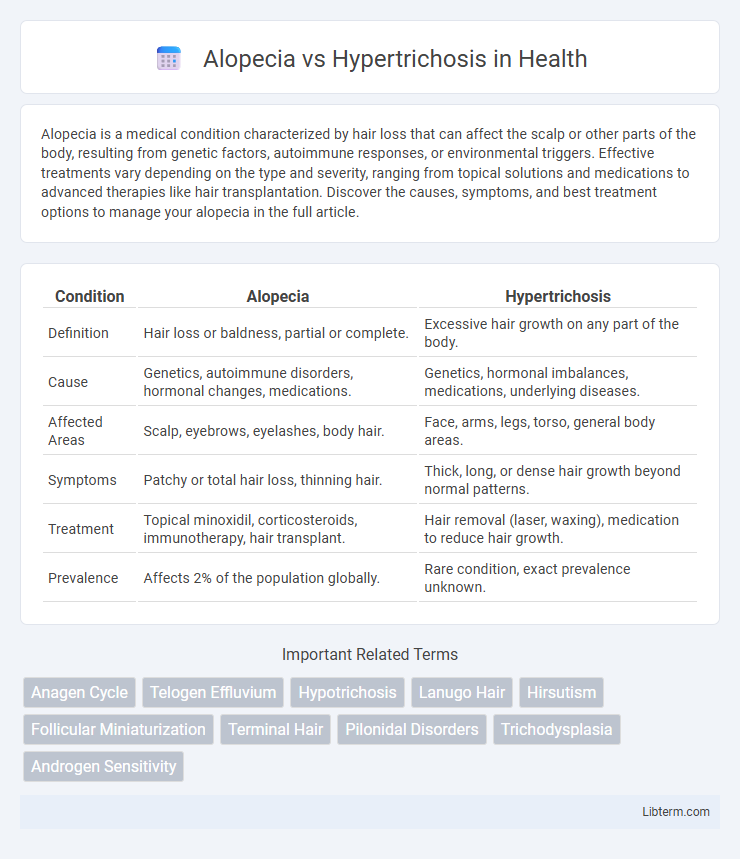Alopecia is a medical condition characterized by hair loss that can affect the scalp or other parts of the body, resulting from genetic factors, autoimmune responses, or environmental triggers. Effective treatments vary depending on the type and severity, ranging from topical solutions and medications to advanced therapies like hair transplantation. Discover the causes, symptoms, and best treatment options to manage your alopecia in the full article.
Table of Comparison
| Condition | Alopecia | Hypertrichosis |
|---|---|---|
| Definition | Hair loss or baldness, partial or complete. | Excessive hair growth on any part of the body. |
| Cause | Genetics, autoimmune disorders, hormonal changes, medications. | Genetics, hormonal imbalances, medications, underlying diseases. |
| Affected Areas | Scalp, eyebrows, eyelashes, body hair. | Face, arms, legs, torso, general body areas. |
| Symptoms | Patchy or total hair loss, thinning hair. | Thick, long, or dense hair growth beyond normal patterns. |
| Treatment | Topical minoxidil, corticosteroids, immunotherapy, hair transplant. | Hair removal (laser, waxing), medication to reduce hair growth. |
| Prevalence | Affects 2% of the population globally. | Rare condition, exact prevalence unknown. |
Understanding Alopecia: Definition and Causes
Alopecia is a medical condition characterized by hair loss from the scalp or other parts of the body, often caused by autoimmune disorders, genetics, hormonal imbalances, or environmental factors. Unlike hypertrichosis, which involves excessive hair growth, alopecia results in partial or complete hair loss, impacting an individual's appearance and confidence. Common forms of alopecia include alopecia areata, androgenetic alopecia, and telogen effluvium, each with distinct underlying causes and treatment approaches.
What is Hypertrichosis? Key Characteristics
Hypertrichosis is a rare condition characterized by excessive hair growth on areas of the body where hair is not normally present or grows minimally, such as the face, arms, and back. This condition differs from alopecia, which involves hair loss or baldness. Key characteristics of hypertrichosis include abnormal hair density, thickness, and often an increase in hair length, which can be congenital or acquired due to underlying causes like medication side effects or systemic diseases.
Types of Alopecia: From Androgenetic to Alopecia Areata
Alopecia encompasses various types including Androgenetic Alopecia, the most common hereditary form characterized by gradual hair thinning, and Alopecia Areata, an autoimmune disorder causing patchy hair loss. Other types include Telogen Effluvium, marked by temporary diffuse shedding triggered by stress or illness, and Cicatricial Alopecia, involving permanent hair loss due to scalp scarring. In contrast, Hypertrichosis involves excessive hair growth beyond normal patterns, unrelated to the autoimmune or genetic mechanisms seen in alopecia types.
Varieties of Hypertrichosis: Congenital vs Acquired
Hypertrichosis manifests in two primary varieties: congenital, present at birth due to genetic mutations, and acquired, developing later in life often triggered by medications, metabolic disorders, or malignancies. Congenital hypertrichosis involves excessive hair growth over large areas or localized patches, while acquired hypertrichosis typically appears as abnormal hair growth in previously unaffected regions. Differentiating these types is crucial for tailored treatment approaches and understanding underlying etiologies in patients presenting with hypertrichosis.
Symptoms: How Alopecia Differs from Hypertrichosis
Alopecia is characterized by patchy or complete hair loss on the scalp or body, resulting in thinning or bald spots, whereas hypertrichosis presents with excessive hair growth in areas not typically hairy. Symptoms of alopecia include smooth, hairless patches with possible inflammation, while hypertrichosis features abnormal thick or coarse hair covering extensive skin regions. Unlike alopecia's hair thinning and follicle miniaturization, hypertrichosis involves hyperactive hair follicles producing unusually dense hair.
Diagnostic Methods for Alopecia and Hypertrichosis
Diagnostic methods for alopecia include scalp biopsy, trichoscopy, and hair pull tests to determine hair loss patterns and underlying causes. For hypertrichosis, diagnosis involves clinical examination, hormonal assays, and sometimes genetic testing to identify excessive hair growth sources. Both conditions require thorough patient history and physical evaluation to differentiate between localized and generalized forms.
Underlying Genetic and Environmental Factors
Alopecia results from genetic mutations affecting hair follicle development and autoimmune responses that cause hair loss, while Hypertrichosis is linked to genetic abnormalities causing excessive hair growth or environmental influences such as drug side effects and metabolic disorders. Both conditions are influenced by genetic predispositions involving specific gene expressions, with alopecia often associated with HLA genes and hypertrichosis connected to anomalies on the X chromosome or autosomes. Environmental triggers, including stress, nutritional deficiencies, and exposure to certain chemicals, can exacerbate alopecia, whereas hormonal imbalances and medications can intensify hypertrichosis symptoms.
Common Treatments: Managing Alopecia and Hypertrichosis
Common treatments for alopecia include corticosteroid injections, minoxidil, and immunotherapy to stimulate hair regrowth and reduce inflammation. Hypertrichosis management often involves laser hair removal, electrolysis, and topical eflornithine cream to inhibit excessive hair growth. Both conditions may require personalized treatment plans based on severity, underlying causes, and patient preferences.
Psychological and Social Impact of Hair Disorders
Alopecia often results in significant psychological distress, including anxiety, depression, and reduced self-esteem due to visible hair loss, which can affect social interactions and quality of life. Hypertrichosis, characterized by excessive hair growth, can lead to social stigma, embarrassment, and challenges in personal and professional settings, impacting mental health and social well-being. Both conditions frequently necessitate psychological support and counseling to manage emotional consequences and improve coping mechanisms in affected individuals.
Prevention and Long-Term Outlook for Patients
Alopecia prevention involves minimizing genetic risk factors, avoiding harsh hair treatments, and managing autoimmune triggers to reduce hair loss progression. Hypertrichosis prevention focuses on identifying and treating underlying hormonal imbalances or medication side effects to control abnormal hair growth. Long-term outlooks vary: alopecia patients may experience partial to complete regrowth with timely intervention, while hypertrichosis management often requires ongoing treatment to maintain normal hair growth levels.
Alopecia Infographic

 libterm.com
libterm.com